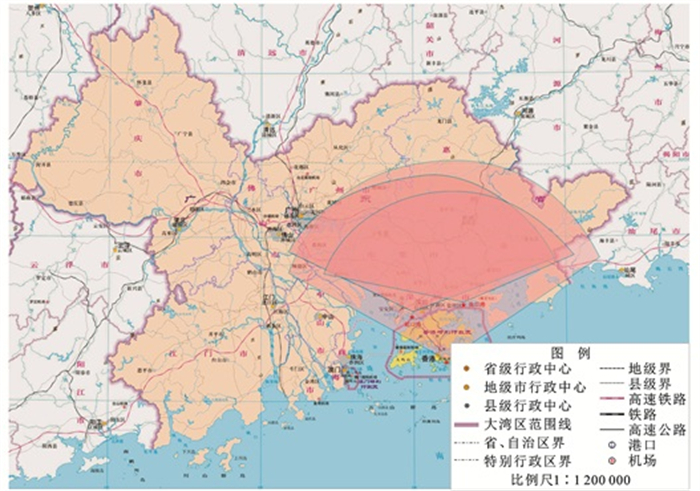-
摘要: 在区域港口发展一体化的背景下,通过调整不同班轮公司的船舶挂靠港口,研究了多港口区域泊位资源的配置与分配问题;为提高泊位利用率,将不同班轮公司组合形成稳定班轮集群,并将多港口区域泊位资源与不同班轮集群之间进行最优匹配,以泊位总数最少和船舶挂靠港口调整最小为目标建立集划分模型,设计了基于排队论和合作博弈理论的三阶段优化方法;以珠江三角洲区域的3个港口(香港港、盐田港和蛇口港)和4个班轮公司的船舶挂靠该区域多港口为例进行算例分析。数值分析结果表明:三阶段优化方法可以使这4个班轮公司的船舶总平均排队长度由23.569 1艘减少至22.930 2艘,即多港口区域的泊位资源整合可以有效缓解港口拥挤和船舶排队;3个港口服务4个班轮公司船舶需配置的泊位数由31减少至27,说明多港口区域的泊位资源的合理配置与分配,不仅可以提高泊位资源利用率,也可以减少不同港口的泊位资源的重复建设;从泊位服务船舶数量的角度,服务不同的班轮集群的船舶对港口的吸引力不同,说明港口可以选择合适的班轮公司作为服务对象来提高泊位运营效率。Abstract: Under the background of integrated regional port development, by adjusting berthing ports for the ships from different liner shipping companies, the configuration and allocation of berth resources in multi-port regions were investigated. To improve berth utilization, different liner shipping companies were combined to form stable liner ship clusters and determine the optimal matching between berth resources and different liner ship clusters in multi-port regions. A set partitioning model was established to minimize the number of berths and berthing ports to be adjusted, and a three-stage optimization approach dependent on the queuing theory and cooperative game theory was presented. Three ports (Hong Kong Port, Yantian Port, and Shekou Port) in the Pearl River Delta region, with the ships from four liner shipping companies berthing at the region, were numerically analyzed. Numerical analysis results show that by using the three-stage optimization approach, the average queuing length of the ships from these four liner shipping companies decreases from 23.569 1 to 22.930 2, therefore the integration of berth resources in multi-port regions is helpful in relieving port congestion and ship queuing. The number of berths to be allocated by three ports serving four liner shipping companies reduces from 31 to 27, indicating that the reasonable configuration and allocation of berth resources in multi-port regions can not only improve berth utilization, but also reduce the repetitive construction of port resources of different ports. From the perspective of the number of ships served by berths, the port has different attractiveness when serving the ships of various liner ship clusters, indicating that the port should properly select liner shipping companies for serving their ships in order to improve the operation effectiveness of berth resources.
-
表 1 COSCO和MSK组成的班轮集群在港时间分布检验
Table 1. Port time distribution test of liner ship clusters composed of COSCO and MSK
h dh ph nph (dh-nph)2/nph 0~4 1 0.016 2 1.701 0 0.288 9 4~8 14 0.109 8 11.529 0 0.529 6 8~12 21 0.194 6 20.433 0 0.015 7 12~16 25 0.207 6 21.798 0 0.470 4 16~20 17 0.171 5 18.007 5 0.056 4 20~24 7 0.121 5 12.757 5 2.598 4 24~28 7 0.077 8 8.169 0 0.167 3 28~32 2 0.046 3 4.861 5 1.684 3 32~36 6 0.026 1 2.740 5 3.876 8 36~40 2 0.014 1 1.480 5 40~44 2 0.007 3 0.766 5 2.121 4 44~48 1 0.003 7 0.388 5 表 2 不同班轮集群的泊松分布和爱尔朗分布的参数
Table 2. Parameters of Poisson distribution and Erlang distribution of different liner ship clusters
班轮集群 λ k μ {HMM,ONE,MSK,COSCO} 30.57 4 1.409 {HMM,ONE,MSK} 25.57 4 1.405 {ONE,MSK,COSCO} 24.43 3 1.467 {HMM,MSK,COSCO} 21.14 4 1.360 {HMM,ONE,COSCO} 20.57 5 1.398 {HMM,ONE} 15.57 4 1.391 {MSK,COSCO} 15.00 4 1.428 {HMM,MSK} 16.14 4 1.342 {ONE,COSCO} 14.43 5 1.492 {HMM,COSCO} 11.14 5 1.301 {ONE,MSK} 19.43 4 1.479 {HMM} 6.14 3 1.204 {COSCO} 5.00 3 1.424 {ONE} 9.43 6 1.533 {MSK} 10.00 4 1.431 表 3 最优泊位数结果
Table 3. Results of optimal berth number
班轮集群 z*/个 π(z*)/艘 {HMM, ONE, MSK, COSCO} 26 22.590 1 {HMM, ONE, MSK} 22 19.100 1 {ONE, MSK, COSCO} 21 17.241 5 {HMM, MSK, COSCO} 19 16.415 7 {HMM, ONE, COSCO} 18 15.574 3 {HMM, ONE} 15 12.024 5 {MSK, COSCO} 14 10.942 0 {HMM, MSK} 14 12.844 2 {ONE, COSCO} 13 10.086 0 {HMM, COSCO} 11 9.282 2 {ONE, MSK} 17 13.634 6 {COSCO} 5 4.111 0 {HMM} 7 5.723 1 {ONE} 9 6.428 0 {MSK} 10 7.307 0 表 4 成本分摊结果
Table 4. Results of cost allocation
班轮集群 每家公司每天分摊的成本/105元 MSK COSCO HMM ONE {HMM, ONE, MSK, COSCO} 6.044 3.246 4.604 5.370 {HMM, ONE, MSK} 6.138 4.591 5.567 {ONE, MSK, COSCO} 6.102 3.232 5.364 {HMM, MSK, COSCO} 5.970 3.442 4.598 {HMM, ONE, COSCO} 3.339 4.598 5.296 {HMM, ONE} 4.641 5.234 {MSK, COSCO} 6.027 3.308 {MSK, HMM} 5.807 4.464 {ONE, COSCO} 3.319 5.289 {HMM, COSCO} 3.279 4.655 {ONE, MSK} 6.189 5.440 不合作 6.237 3.518 4.894 5.488 表 5 班轮集群稳定性
Table 5. Liner ship clusters stability
案例 班轮集群 每家公司每天分摊的成本/105元 MSK COSCO HMM ONE 1 2家班轮公司 {ONE,MSK} 6.189 5.440 {ONE,COSCO} 3.319 5.289 {MSK,COSCO} 6.027 3.308 3家班轮公司 {ONE,MSK,COSCO} 6.102 3.232 5.364 不参与合作 6.237 3.518 4.894 5.488 2 2家班轮公司 {HMM,ONE} 4.641 5.234 {HMM,MSK} 5.807 4.464 {ONE,MSK} 6.189 5.440 3家班轮公司 {HMM,ONE,MSK} 6.138 4.591 5.567 不参与合作 6.237 3.518 4.894 5.488 -
[1] GUI Dong-ping, WANG Hai-yan, YU Meng. Risk assessment of port congestion risk during the COVID-19 pandemic[J]. Journal of Marine Science and Engineering, 2022, 10(2): 150. doi: 10.3390/jmse10020150 [2] 王伟, 纪翌佳, 金凤君. 基于动态空间面板模型的中国港口竞争与合作关系研究[J]. 地理研究, 2022, 41(3): 616-632. https://www.cnki.com.cn/Article/CJFDTOTAL-DLYJ202203002.htmWANG Wei, JI Yi-jia, JIN Feng-jun. The competition and cooperation relationship of Chinese Ports based on dynamic spatial panel model[J]. Geographical Research, 2022, 41(3): 616-632. (in Chinese) https://www.cnki.com.cn/Article/CJFDTOTAL-DLYJ202203002.htm [3] 范志强. 连续泊位分配问题研究: 模型优化与计算分析[J]. 工业工程与管理, 2016, 21(3): 81-87. https://www.cnki.com.cn/Article/CJFDTOTAL-GYGC201603011.htmFAN Zhi-qiang. Research on continuous berth allocation problem: model comparison and computational analysis[J]. Industrial Engineering and Management, 2016, 21(3): 81-87. (in Chinese) https://www.cnki.com.cn/Article/CJFDTOTAL-GYGC201603011.htm [4] BARBOSA F, BERBERT RAMPAZZO P C, YAMAKAMI A, et al. The use of frontier techniques to identify efficient solutions for the berth allocation problem solved with a hybrid evolutionary algorithm[J]. Computers and Operations Research, 2019, 107: 43-60. doi: 10.1016/j.cor.2019.01.017 [5] URSAVAS E, ZHU S X. Optimal policies for the berth allocation problem under stochastic nature[J]. European Journal of Operational Research, 2016, 255(2): 380-387. doi: 10.1016/j.ejor.2016.04.029 [6] LALLA-RUIZ E, EXPÓSITO-IZQUIERDO C, MELIÁN-BATISTA B, et al. A set-partitioning-based model for the berth allocation problem under time-dependent limitations[J]. European Journal of Operational Research, 2016, 250(3): 1001-1012. doi: 10.1016/j.ejor.2015.10.021 [7] XIANG Xi, LIU Chang-chun, MIAO Li-xin. A bi-objective robust model for berth allocation scheduling under uncertainty[J]. Transportation Research Part E: Logistics and Transportation Review, 2017, 106: 294-319. doi: 10.1016/j.tre.2017.07.006 [8] XU Ya, CHEN Qiu-shuang, QUAN Xiong-wen. Robust berth scheduling with uncertain vessel delay and handling time[J]. Annals of Operations Research, 2012, 192(1): 123-140. doi: 10.1007/s10479-010-0820-0 [9] SCHEPLER X, BALEV S, MICHEL S, et al. Global planning in a multi-terminal and multi-modal maritime container port[J]. Transportation Research Part E: Logistics and Transportation Review, 2017, 100: 38-62. doi: 10.1016/j.tre.2016.12.002 [10] IMAI A, NISHIMURA E, PAPADIMITRIOU S. The dynamic berth allocation problem for a container port[J]. Transportation Research Part B: Methodological, 2001, 35(4): 401-417. doi: 10.1016/S0191-2615(99)00057-0 [11] CORRECHER J F, ALVAREZ-VALDES R, TAMARIT J M. New exact methods for the time-invariant berth allocation and quay crane assignment problem[J]. European Journal of Operational Research, 2019, 275(1): 80-92. doi: 10.1016/j.ejor.2018.11.007 [12] ZHENG Jian-feng, YANG Ling-xiao, HAN Wen-cheng, et al. Berth assignment for liner carrier clusters under a cooperative environment[J]. Computers and Operations Research, 2021, 136: 105486. doi: 10.1016/j.cor.2021.105486 [13] ILATI G, SHEIKHOLESLAMI A, HASSANNAYEBI E. A simulation-based optimization approach for integrated port resource allocation problem[J]. PROMET—Traffic and Transportation, 2014, 26(3): 243-255. doi: 10.7307/ptt.v26i3.1337 [14] LEGATO P, MAZZA R M, GULLÌ D. Integrating tactical and operational berth allocation decisions via simulation-optimization[J]. Computers and Industrial Engineering, 2014, 78: 84-94. doi: 10.1016/j.cie.2014.10.003 [15] SAEED N, LARSEN O. Application of queuing methodology to analyze congestion: a case study of the Manila International Container Terminal, Philippines[J]. Case Studies on Transport Policy, 2016, 4(2): 143-149. doi: 10.1016/j.cstp.2016.02.001 [16] EL-NAGGAR M. Application of queuing theory to the container terminal at Alexandria seaport[J]. Journal of Soil Science and Environmental Management, 2010, 1(4): 77-85. [17] DRAGOVI AC'G B, PARK N K, RADMILOVI AC'G Z. Ship-berth link performance evaluation: simulation and analytical approaches[J]. Maritime Policy and Management, 2006, 33(3): 281-299. doi: 10.1080/03088830600783277 [18] KOZAN E. Analysis of the economic effects of alternative investment decisions for seaport systems[J]. Transportation Planning and Technology, 1994, 18(3): 239-248. doi: 10.1080/03081069408717546 [19] SEN P. Optimal priority assignment in queues: application to marine congestion problems[J]. Maritime Policy and Management, 1980, 7(3): 175-184. doi: 10.1080/03088838000000019 [20] EDMOND E D, MAGGS R P. How useful are queue models in port investment decisions for container berths?[J]. Journal of the Operational Research Society, 1978, 29(8): 741-750. doi: 10.1057/jors.1978.162 [21] 张恒, 陈秋双. 考虑船舶废气排放的港口群协同泊位分配研究[J]. 交通运输系统工程与信息, 2014, 14(4): 99-106. https://www.cnki.com.cn/Article/CJFDTOTAL-YSXT201404015.htmZHANG Heng, CHEN Qiu-shuang. Coordinated berth allocation for port group considering vessel emissions[J]. Journal of Transportation Systems Engineering and Information Technology, 2014, 14(4): 99-106. (in Chinese) https://www.cnki.com.cn/Article/CJFDTOTAL-YSXT201404015.htm [22] 徐亚, 杜玉泉, 龙磊. 支持多码头协调运作的泊位调度模型和算法[J]. 系统工程, 2015, 33(1): 128-138. https://www.cnki.com.cn/Article/CJFDTOTAL-GCXT201501019.htmXU Ya, DU Yu-quan, LONG Lei. Berth scheduling model and algorithm for coordinated operation of multiple container terminals in a port[J]. Systems Engineering, 2015, 33(1): 128-138. (in Chinese) https://www.cnki.com.cn/Article/CJFDTOTAL-GCXT201501019.htm [23] VENTURINI G, IRIS Ç, KONTOVAS C A, et al. The multi- port berth allocation problem with speed optimization and emission considerations[J]. Transportation Research Part D: Transport and Environment, 2017, 54: 142-159. doi: 10.1016/j.trd.2017.05.002 [24] 毕娅, 李文锋. 集装箱港口集群下多港口多泊位联合调度方法[J]. 计算机应用, 2012, 32(2): 448-451. https://www.cnki.com.cn/Article/CJFDTOTAL-JSJY201202038.htmBI Ya, LI Wen-feng. Multi-port and multi-berth integrated scheduling based on container port cluster[J]. Journal of Computer Applications, 2012, 32(2): 448-451. (in Chinese) https://www.cnki.com.cn/Article/CJFDTOTAL-JSJY201202038.htm [25] GUO Li-ming, ZHENG Jian-feng, DU Hao-ming, et al. The berth assignment and allocation problem considering cooperative liner carriers[J]. Transportation Research Part E: Logistics and Transportation Review, 2022, 164: 102793. doi: 10.1016/j.tre.2022.102793 [26] 梅益群, 韩晓龙. 考虑泊位偏好和岸桥移动的泊位岸桥联合调度[J]. 计算机工程与应用, 2022, 58(6): 241-249. https://www.cnki.com.cn/Article/CJFDTOTAL-JSGG202206024.htmMEI Yi-qun, HAN Xiao-long. Joint scheduling of berths and quay cranes considering berth preference and quay crane movement[J]. Computer Engineering and Applications, 2022, 58(6): 241-249. (in Chinese) https://www.cnki.com.cn/Article/CJFDTOTAL-JSGG202206024.htm [27] 焦小刚, 郑斐峰, 徐寅峰, 等. 考虑泊位疏浚的连续型泊位和动态岸桥联合调度[J]. 运筹与管理, 2020, 29(2): 47-57. https://www.cnki.com.cn/Article/CJFDTOTAL-YCGL202002007.htmJIAO Xiao-gang, ZHENG Fei-feng, XU Yin-feng, et al. Integrated continuous berth allocation and time-variant quay crane assignment under berth dredging in container terminal[J]. Operations Research and Management Science, 2020, 29(2): 47-57. (in Chinese) https://www.cnki.com.cn/Article/CJFDTOTAL-YCGL202002007.htm [28] KIMURA T. Approximations for multi-server queues: system interpolations[J]. Queueing Systems, 1994, 17(3): 347-382. [29] 张一诺. 港口通用泊位最佳数量的计算方法[J]. 系统工程理论与实践, 1983(1): 35-41. https://www.cnki.com.cn/Article/CJFDTOTAL-XTLL198301009.htmZHANG Yi-nuo. Calculation method of optimal number of port general berths[J]. System Engineering Theory and Practice, 1983(1): 35-41. (in Chinese) https://www.cnki.com.cn/Article/CJFDTOTAL-XTLL198301009.htm -





 下载:
下载:






